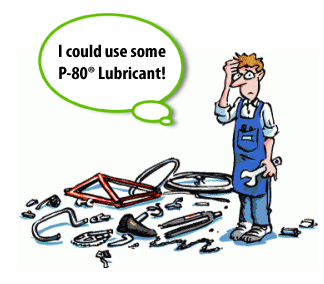5 Ways Temporary Rubber Lubricants Can Help Ease Assembly
Tweet
 Print
Print
How many times have you tried to push an O-ring into place only to have it pop right back out? Or tried to push a rubber hose onto a pipe only to find it wouldn’t slide into place because the fit was just too tight? These tasks can be very frustrating and can often require considerable physical effort and time.
Rubber materials are inherently difficult to install, remove, or otherwise manipulate – even when wet. The slip resistant nature of rubber creates a challenge during the assembly and repair of rubber parts. Common assembly problems that may occur include ill-fitting, misaligned or damaged parts, rolling O-rings, uneven cuts, and worker injury. Using temporary rubber assembly lubricants can solve these problems.
Temporary rubber assembly lubricants can:
1. Reduce Installation Force:
A thin film of lubricant applied to a part fills in any gaps, holes, or spaces between two separate surfaces, allowing them to slide across each other. By reducing the surface tension between the two surfaces, rubber parts can slide into place easily, providing a tight fit.
2. Achieve Closer Fits:
Engineers can design lower tolerance parts. The force needed to install the parts when a lubricant is used is greatly reduced. Since the lubrication is only temporary, once dry, the parts stay in place resulting in a tight fit.
3. Improve Product Performance:
Improper part alignment can lead to part failure and safety issues. Using a rubber assembly lubricant, which enables the parts to slide easily into place, can solve these problems by reducing or eliminating damage to parts.
4. Increase Production Rates:
Applying an assembly lubricant to the rubber part makes the rubber slippery, so parts can easily slide into place. After the lubricant dries, the lubricity goes away and mated parts maintain a tight fit. The assembly process becomes more productive because it is easier and quicker.
5. Help to Avoid Worker Injuries:
Lubricants reduce the insertion force needed for rubber assembly. Workers can more easily push parts into place, reducing the amount of musculoskeletal, slippage, and repetitive stress related injuries that can be caused by using too much force to insert a rubber part.
The next time you’re having trouble replacing a pump seal, inserting a grommet, or pushing a hose into place, try using a temporary rubber assembly lubricant and see how much easier the job becomes. Temporary lubricants are ideal for rubber assembly because they reduce the friction needed to assemble parts.
Want more information about temporary rubber assembly lubricants, including how to use them and factors to consider when choosing a lubricant? Download IPC’s free P-80 webinar. Or contact our technical team to help you find the best solution for your assembly needs at mkt@ipcol.com.
Tweet
 Print
Print